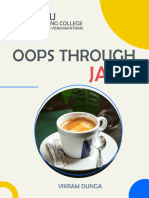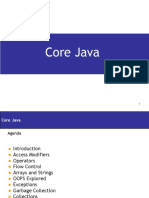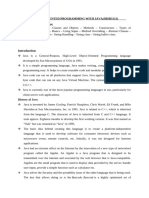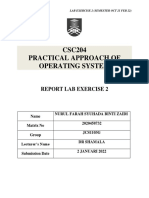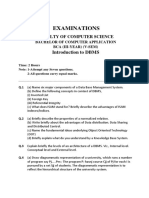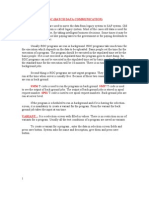Java Oop
Uploaded by
Mohammed ElmadaniJava Oop
Uploaded by
Mohammed ElmadaniOOP Notes: Page 1 of 4
Introduction to OOP
Lecture 1
Introduction to OOP
OOP Language
OOP Stands for "Object-Oriented Programming." refers to a programming methodology based on objects,
instead of just functions and procedures. These objects are organized into classes, which allow individual objects
to be group together.
Structured Programming Language
It is a programming language based on the use of block structures, subroutines, for and while loops.
Difference between Structured Programming and Object Oriented
Structured Programming Object Oriented Programming
Structured Programming is designed which focuses Object Oriented Programming is designed
on process/ logical structure and then data required which focuses on data.
for that process.
Structured programming follows top-down Object oriented programming follows bottom-
approach. up approach.
Structured Programming is also known as Modular Object Oriented Programming
Programming and a subset of procedural supports inheritance, encapsulation,
programming language. abstraction, polymorphism, etc.
In Structured Programming, Programs are divided In Object Oriented Programming, Programs are
into small self contained functions. divided into small entities called objects.
Structured Programming is less secure as there is Object Oriented Programming is more secure as
no way of data hiding. having data hiding feature.
Structured Programming can Object Oriented Programming can solve
solve moderately complex programs. any complex programs.
Structured Programming provides less reusability, Object Oriented Programming provides more
more function dependency. reusability, less function dependency.
Less abstraction and less flexibility. More abstraction and more flexibility.
In this course Java Language will be used to introduce Object Oriented Programming.
The Top-Down approach vs The Bottom-Up approach programming
While the top-down approach focuses on breaking down a big problem into smaller and understandable chunks,
the bottom-up approach first focuses on solving the smaller problems at the fundamental level and then
integrating them into a whole and complete solution.
Misurata University 2022 Department of Computer Science
OOP Notes: Page 2 of 4
Introduction to OOP
Java Editions
1- J2SE (Java 2 Standard Edition):
Java Platform Standard Edition is known as Core Java and is the most basic and standard version of Java. It is
the purest form of Java and is the foundation of all the other editions. It contains a variety of general-purpose
APIs, including Java.Lang, Java.util, etc.
2- J2ME (Java 2 Micro Edition):
This version is used for the applications that run on the embedded system, smartphones, and small devices.
There are many reasons for that, mostly because it limits the processing power, battery limitations, small display,
etc. In a way, it was built for developing apps for small devices.
3- J2EE (Java 2 Enterprise Edition):
The enterprise version of Java is widely used and is more versatile than any other version of Java. It is used in
the development of web services, networking apps, server-side scripting, and also other various types of web-
based applications.
Structure of a Java Class
This week you should be entering, compiling, and executing a simple Java class which produced output to the
screen.
The following line says that this program is a class called HelloLibya
public class HelloLibya
{
public static void main(String[] args)
{
// welcome the user
System.out.println(“Hello Libya.”);
}
}
A slightly different class is given below
public class OutExample
{
// simple Java class to illustrate difference between print and println
public static void main(String[] args)
{
// this is the body of the main method
System.out.println(“This will appear on the first line” + “ so will this”);
System.out.println(“ and this”);
System.out.print(“This will appear on the next line”);
}
}
SAQ 1
What do you understand by the terms, comment, special symbol, identifier and keyword? Annotate the above
classes showing examples of each. Which elements of the above classes are essential in order to get the class to
compile?
Integer Expressions
Integer expressions are formed using integer values (whole numbers) and integer operators (+ - / * %).You may
directly output the results of arithmetic expressions using println and print as shown in the class fragment below:
Misurata University 2022 Department of Computer Science
OOP Notes: Page 3 of 4
Introduction to OOP
System.out.println(5 / 3 * 2); // outputs 2
System.out.println(7 / 3 + 2); // outputs 4
SAQ 2
Identify the operators available for use with integers; put the operators in order of precedence.
Exercise 1
Evaluate each of the following integer expressions
17 / 5 + 2
19 / 5 + 4
5 * (3 + 6) / 2
5* 3+6/2
14 - 10 * 3 / 4
36 + 4 * 2 – 17
The only operator that some of you are likely to be unfamiliar with is the modulo operator. For positive numbers
it gives the remainder of an integer division, e.g. 7 % 2 yields 1. For negative integers the modulo operator
requires a little bit more consideration.
Exercise 2
Consider Exercise 1.2 in Bailey and Bailey. This requires you to write a program to discover the various results
of using the % operator. e.g. – 16 % 3, 16 % -3, -16 % -3. Work out what results you would expect, and then
modify your first Java program to test the results.
Variables and Constants
Virtually every class you will ever write will require you to declare some data. To declare variables of type
integer you use the keyword int as shown in Bailey and Bailey p 15.
If you wish to declare a data item whose value may not change (a constant) then use the keyword final and assign
a value to it.
public class GameScores
{
public static void main(String [] args)
{
final int scores = 6; // a constant
int score1, score2, score3, score4, score5, score6;
int total; //variable declaration
score1 = 10; // assigns value to variable
score2 = 20;
score3 = 15;
score4 = 17;
score5 = 11;
score6 = 14;
total = score1 + score2 + score3 + score4 + score5 + score6;
System.out.println(“Total Scored : ” + total);
}
}
Exercise 3
Amend the above class so that it also calculates and outputs a mean for the scores.
SAQ 3
What is the meaning of the following terms : final values; declaration; assignment.
Misurata University 2022 Department of Computer Science
OOP Notes: Page 4 of 4
Introduction to OOP
Consider the class on page 16-17 of Bailey and Bailey, which provides a sequence of assignment statements.
You should notice a key feature of the statements in this class is that the same identifier appears on the left hand
and right hand side of the = operator.
sum = sum + 1;
Exercise 4
Consider what would be output at the end of the following fragment of code:
Sum = 26;
Sum = sum + sum * 2;
System.out.println(sum);
Finally, consider what happens when you attempt to assign out of range values to an integer variable. Bailey and
Bailey show on page 13 what would happen when you attempted to give an integer an explicit value larger than
2147483647. The compiler would not however, detect the following violation:
big = 2147483647;
big = big +1;
Try this, and see what happens.
Misurata University 2022 Department of Computer Science
You might also like
- Library Management System For Stanford AmritaJain PDFNo ratings yetLibrary Management System For Stanford AmritaJain PDF9 pages
- Java Programming - Day 1: Long Cycle - JEENo ratings yetJava Programming - Day 1: Long Cycle - JEE65 pages
- Paper-X - Programming Language Java and Java ScriptNo ratings yetPaper-X - Programming Language Java and Java Script234 pages
- Contents at A Glance: Assessment Tests LixNo ratings yetContents at A Glance: Assessment Tests Lix19 pages
- (Always Learning) Pandey, Hari Mohan - Java Programming-Dorling Kindersley (India) - Pearson (2012)100% (1)(Always Learning) Pandey, Hari Mohan - Java Programming-Dorling Kindersley (India) - Pearson (2012)889 pages
- Lecture 02 - Annotated - Programming Languages - Classes and Objects P1No ratings yetLecture 02 - Annotated - Programming Languages - Classes and Objects P162 pages
- Java OOP (Object Oriented Programming) : Programming Department Fifth Stage 2017-2018No ratings yetJava OOP (Object Oriented Programming) : Programming Department Fifth Stage 2017-201810 pages
- Java Programming (20A05505A) : Iii - B.Techi-SemesterNo ratings yetJava Programming (20A05505A) : Iii - B.Techi-Semester553 pages
- Somasekhara - OBJECT ORIENTED PROGRAMMING WITH JAVA - Sample ChaptersNo ratings yetSomasekhara - OBJECT ORIENTED PROGRAMMING WITH JAVA - Sample Chapters33 pages
- Expressions: Slides Are Adapted From The Originals Available atNo ratings yetExpressions: Slides Are Adapted From The Originals Available at44 pages
- IGNOU PGDCA MCS 206 Object Oriented Programming using Java Previous Years solved PapersFrom EverandIGNOU PGDCA MCS 206 Object Oriented Programming using Java Previous Years solved PapersNo ratings yet
- Composing Software: An Exploration of Functional Programming and Object Composition in JavaScriptFrom EverandComposing Software: An Exploration of Functional Programming and Object Composition in JavaScriptNo ratings yet
- WebSphere MQ Server With Temenos T24 - Part 2 - Echoes of Imran100% (1)WebSphere MQ Server With Temenos T24 - Part 2 - Echoes of Imran1 page
- Week 4 Arithmetic, Relational Operators and Conditional StatementsNo ratings yetWeek 4 Arithmetic, Relational Operators and Conditional Statements50 pages
- React Architecture Patterns for Your ProjectsNo ratings yetReact Architecture Patterns for Your Projects24 pages
- F in Action A Revised Edition of Get Programming with F Isaac Abraham - The special ebook edition is available for download nowNo ratings yetF in Action A Revised Edition of Get Programming with F Isaac Abraham - The special ebook edition is available for download now55 pages
- Creating A Resourcebundle: "En" "Us" "Jenkov - Property.Mybundle" "Label1"No ratings yetCreating A Resourcebundle: "En" "Us" "Jenkov - Property.Mybundle" "Label1"2 pages
- Introduction To Unix: Unit 2:the File System and Some File Handling CommandsNo ratings yetIntroduction To Unix: Unit 2:the File System and Some File Handling Commands62 pages
- Visual Basic 2008 For Dummies Bill Sempf download100% (1)Visual Basic 2008 For Dummies Bill Sempf download57 pages



















